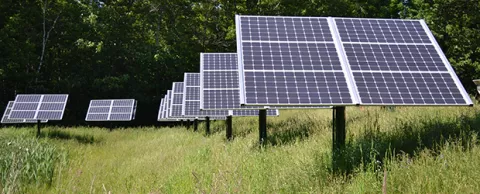
If you’ve been holding off on renewable energy because it’s too expensive, you are running out of excuses. Last year, for the first time ever, renewable energy accounted for a majority of the new production that came online.
And rapidly developing nations are leading the way. Emerging markets like China, India and Brazil accounted for half the new investment. Not long ago, they simply would have opted for coal, citing its cost advantage. But that cost benefit is rapidly eroding. In fact, renewable sources may soon have that advantage.
The cost of generating land-based wind power has dropped 14% over the past five years; solar generation costs have dropped more than 60%. And by 2020, India’s solar power may be 10% cheaper than coal.
Of course, moving to renewable sources quicker is better for the environment, but as the overall balance tips toward renewable energy, there’s also a financial reason to make the move. Read on for new renewable energy projects of note. And for more great ideas, please check out our recent Smart Energy Special Theme Edition. — Kevin Ebi
As renewable energy has become the largest new source of power, Council Associate Partner Enel has announced several new projects to build on its already sizable commitment to clean energy sources.
Speaking at the Bloomberg Future of Energy Summit 2016 in New York City, Enel Green Power CEO Francesco Venturini said Enel is moving toward doubling the amount of renewable capacity it adds each year. Worldwide, Enel now has about 11 GW of renewable energy capacity and it’s moving from adding 1 GW annually to 2.
Hybrid facility boosts and stabilizes production
Enel inaugurated a triple renewable hybrid plant in Fallon, Nevada, the world’s first plant that combines medium enthalpy, binary cycle geothermal, solar thermal and solar photovoltaic technologies at the same site.
By taking advantage of complementary power sources, Enel is to improve overall efficiency and smooth out fluctuations. For example, solar is more effective on hot sunny days when geothermal is less efficient. A study showed this combination boosted overall output by nearly 4%. Locating them together also allows them to share infrastructure.
Brazil meets power needs with new solar park
Enel Green Power Brasil Participações has started work on the Lapa solar park, two facilities that will be able to supply 166,000 Brazilian households with power while avoiding 198,000 tons of CO2 emissions. The park is located in an area of especially strong solar radiation.
Of the subsidiary’s current capacity, only about 2% comes from solar (nearly 80% is from wind), but of its new projects, solar makes up the lion’s share — nearly double the wind capacity that’s under development and nearly eight times the hydro development.
Enel’s Mexico subsidiary is also boosting its solar work in that country. It’s investing about $1 billion in new solar facilities after winning the largest share of solar production in a new government tender.
More stories …
Is your city’s energy renewable? (If not, you could soon become a fossil)
Energy storage: hot on the heels of the renewables wave
Wait... carbon dioxide could be GOOD for cities? (GE has an idea)



